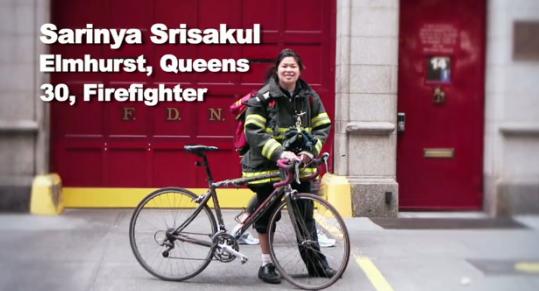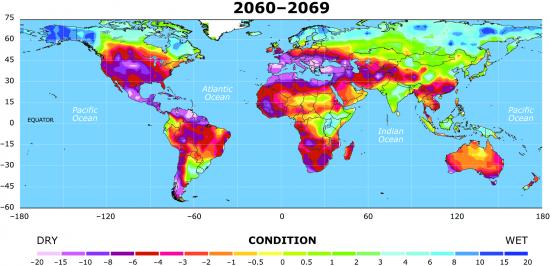County Commissioner: “There’s no economic growth whatsoever. It’s going to have to be wind energy or we’ll die.”
Actual NY Times caption: “A church made an apt request.”
Media miscoverage of climate change comes in many forms. We still have false balance between climate science and denial, contrary to the myth of flawed analyses. And we have general under-coverage of the story of the century (Media coverage of climate change “fell off the map” in 2010).
Among the most troublesome forms of miscoverage are stories on extreme weather or a changing climate that make no mention of climate change whatsoever or actually mis-state what climate scientists believe [see “if the NY Times can’t tell the (bark beetle) story (twice!), how will the public hear it?“]. That latter mistake was on full display today with a front-page (!) story, “Town, Survivor of Dust Bowl, Now Battles a Fiercer Drought.” The story begins well:
While tornadoes and floods have ravaged the South and the Midwest, the remote western edge of the Oklahoma Panhandle is quietly enduring a weather calamity of its own: its longest drought on record, even worse than the Dust Bowl, when incessant winds scooped up the soil into billowing black clouds and rolled it through this town like bowling balls.
With a drought continuing to punish much of the Great Plains, this one stands out. Boise (rhymes with voice) City has gone 222 consecutive days through Tuesday with less than a quarter-inch of rainfall in any single day, said Gary McManus, a state climatologist. That is the longest such dry spell here since note-keeping began in 1908.
But then the piece veers sharply off course in the very next sentence:
The Dust Bowl of the 1930s, caused in part by the careless gouging of the earth in an effort to farm it, created an epic environmental disaster. Experts say it is unlikely to be repeated because farming has changed so much.
No, no, a thousand times no. Well, a dozen-studies no, in any case.
Yes, human actions helped created the 1930s Dust Bowls. Guess what, multiple scientific studies make clear human actions make it likely we will see a repeat — indeed, we are on a path for far worse than the Dust Bowls.
Ironically — or is that embarrassingly? – the NY Times actually ran a photo of a church calling on people to “pray for rain” with a caption calling it an “apt request.” Really, former paper of record? Prayer is the apt response? How about accurate reporting of the science? Would that be apt?
I went through that literature last month in my post “USGS on Dust-Bowlification: Drier conditions projected to accelerate dust storms in the U.S. Southwest.” With apologies to regular readers, as long as the major “prestige media” continues to miscover the story, I’m going to keep reposting the ever-growing body of literature on the ever-growing danger of Dust-Bowlification we face from our ever-growing levels of greenhouse gases.
First, though it is worth noting that the NYT story makes no mention of climate change at all. Second, the NYT does end with this remarkable pro-wind bit:
John Freeman, a county commissioner, estimated that 3,000 trucks a day passed through now and provided half the county’s sales tax revenues. He hopes the county can make up for that loss, several times over, by harnessing the inexhaustible supply of wind. But the permitting process for wind farms takes years, and transmission power lines are not yet built.
Like many other small towns that survived the Dust Bowl, Boise City now seems on the verge of extinction.
“There’s no economic growth whatsoever,” Mr. Freeman lamented. “It’s going to have to be wind energy or we’ll die.”
Talk about burying a great story
The USGS study itself concludes:
Thus the effects of increased temperature on perennial plant cover and the correlation of declining plant cover with increased aeolian flux strongly suggest that sustained drought conditions across the southwest will accelerate the likelihood of dust production in the future on disturbed soil surfaces.
That’s now my new favorite euphemism for a massive dust storm — “increased aeolian flux.”
A number of major recent studies warn that the Southwest (along with many other highly populated parts of the globe) is likely headed toward sustained — if not near permanent — drought and Dust Bowl-like conditions if we stay anywhere near our current emissions path.
- NOAA: Climate change “largely irreversible for 1000 years,” with permanent Dust Bowls in Southwest and around the globe. This January 2009 PNAS paper finds
…the climate change that is taking place because of increases in carbon dioxide concentration is largely irreversible for 1,000 years after emissions stop…. Among illustrative irreversible impacts that should be expected if atmospheric carbon dioxide concentrations increase from current levels near 385 parts per million by volume (ppmv) to a peak of 450-600 ppmv over the coming century are irreversible dry-season rainfall reductions in several regions comparable to those of the ”dust bowl” era
The irreversible precipitation changes hit the U.S. Southwest, Southeast Asia, Eastern South America, Western Australia, Southern Europe, Southern Africa, and northern Africa.
Note also that this is only 450 to 600 ppm. We’re on track for 800 to 1000 ppm this century on our current emissions path — a path we are sure to stay on if we listen to the do-little we-can-adapt crowd (see “Our hellish future: Definitive NOAA-led report on U.S. climate impacts warns of scorching 9 to 11°F warming over most of inland U.S. by 2090 with Kansas above 90°F some 120 days a year — and that isn’t the worst case, it’s business as usual!” and M.I.T. doubles its 2095 warming projection to 10°F — with 866 ppm and Arctic warming of 20°F).
- Back in October, the National Center for Atmospheric Research published a complete literature review, “Drought under global warming: a review,” (See NCAR analysis warns we risk multiple, devastating global droughts even on moderate emissions path). That study makes clear that Dust-Bowlification may be the impact of human-caused climate change that hits the most people by mid-century, as the figure below suggests (click to enlarge, “a reading of -4 or below is considered extreme drought”):
The PDSI [Palmer Drought Severity Index] in the Great Plains during the Dust Bowl apparently spiked very briefly to -6, but otherwise rarely exceeded -3 for the decade (see here).
The large-scale pattern shown in Figure 11 [of which the figure above is part] appears to be a robust response to increased GHGs. This is very alarming because if the drying is anything resembling Figure 11, a very large population will be severely affected in the coming decades over the whole United States, southern Europe, Southeast Asia, Brazil, Chile, Australia, and most of Africa.
The National Center for Atmospheric Research notes “By the end of the century, many populated areas, including parts of the United States, could face readings in the range of -8 to -10, and much of the Mediterranean could fall to -15 to -20. Such readings would be almost unprecedented.”
For the record, the NCAR study merely models the IPCC’s “moderate” A1B scenario — atmospheric concentrations of CO2 around 520 ppm in 2050 and 700 in 2100. We’re currently on the A1F1 pathway, which would takes us to 1000 ppm by century’s end, but I’m sure with an aggressive program of energy R&D we could keep that to, say 900 ppm.
- The UK Met Office came to a similar view four years ago in their analysis, projecting severe drought over 40% of the Earth’s habited landmass by century’s end (see “The Century of Drought“).
The projection of extended if not endless drought for the US Southwest has been studied a great deal:
- In 2007, Science (subs. req’d) published research that “predicted a permanent drought by 2050 throughout the Southwest” — levels of aridity comparable to the 1930s Dust Bowl would stretch from Kansas to California. And they were also only looking at a 720 ppm case.
- In December 2008, the Bush Administration quietly released a US Geological Survey stunner: SW faces “permanent drying” by 2050, which found:
The serious hydrological changes and impacts known to have occurred in both historic and prehistoric times over North America reflect large-scale changes in the climate system that can develop in a matter of years and, in the case of the more severe past megadroughts, persist for decades. Such hydrological changes fit the definition of abrupt change because they occur faster than the time scales needed for human and natural systems to adapt, leading to substantial disruptions in those systems. In the Southwest, for example, the models project a permanent drying by the mid-21st century that reaches the level of aridity seen in historical droughts, and a quarter of the projections may reach this level of aridity much earlier.
An unprecedented combination of heat plus decades of drought could be in store for the Southwest sometime this century, suggests new research from a University of Arizona-led team….
“The bottom line is, we could have a Medieval-style drought with even warmer temperatures,” [lead author Connie] Woodhouse said.
- A new Environmental Research Letters article, “Characterizing changes in drought risk for the United States from climate change,” comes to a similar conclusion as the NCAR study, “Drought frequencies and uncertainties in their projection tend to increase considerably over time and show a strong worsening trend along higher greenhouse gas emissions scenarios, suggesting substantial benefits for greenhouse gas emissions reductions.” See especially Figure 4C.
That’s something for the adapters to plan for and the rest of the world to suffer through if we’re too greedy and ignorant to spend a small fraction of our wealth on mitigation to avoid it.
If you want to know what a serious dust storm looks like, the place to go is the canary in the coal mine for climate change — Australia. Here’s an amazing video of ‘increased aeolian flux’ in Australia:
Here’s another incredible video of the great Sydney Dust Storm of September ‘09:
As NASA’s Earth Observatory described the superstorm:
A wall of dust stretched from northern Queensland to the southern tip of eastern Australia on the morning of Septembe
r 23, 2009, when the Moderate Resolution Imaging Spectroradiometer (MODIS) on NASA’s Terra satellite captured this image [see amazing photo below]. The dust is thick enough that the land beneath it is not visible. The storm, the worst in 70 years, led to canceled or delayed flights, traffic problems, and health issues, reported the Australian Broadcasting Corporation (ABC) News. The concentration of particles in the air reached 15,000 micrograms per cubic meter in New South Wales during the storm, said ABC News. A normal day sees a particle concentration 10-20 micrograms per cubic meter.
Something to look forward to — especially if the media keeps miscovering the story, telling the public there is nothing to worry about, until it is too late.




